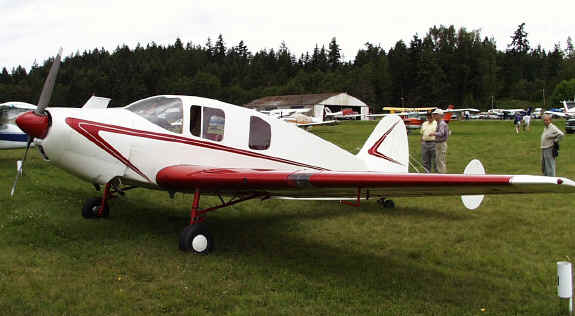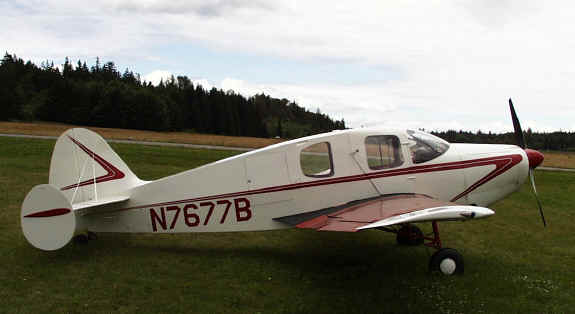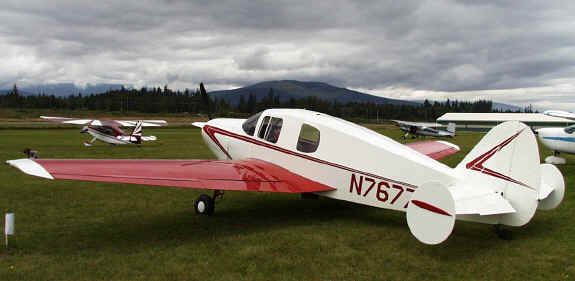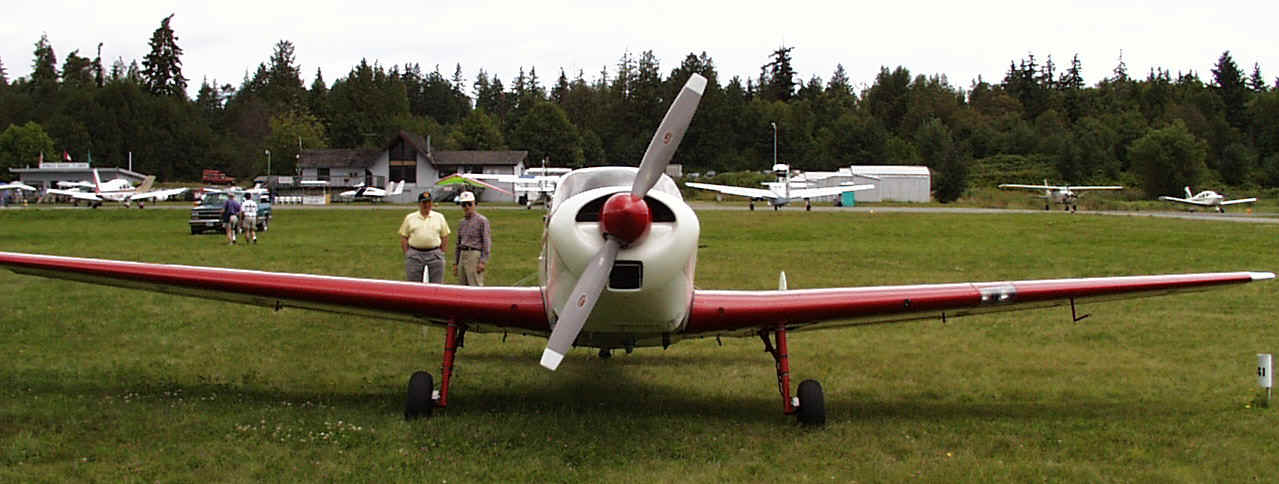General Description
This aircraft N7677B belongs to me and is a 1958 230hp 14-19-2.

Notice the wing - no rivets. The wing is almost purely wood, with wooden spars and ribs skinned with plywood covered with fabric. The resulting finish is completely smooth, which makes the aircraft look like a modern-day fiberglass/composite aircraft. This usually confuses bystanders who often feel compelled to walk up and knock on wood.
Although it is the butt of numerous termite jokes, the wing is quite strong and is basically the same wing that is used in the Viking series of aircraft with much higher gross weights. Bellanca wings are reputed to met up with rather large fenceposts during off-airport emergency landings, and the Bellanca wing has won.

The fuselage of the aircraft is welded steel tubing covered with fabric, which is a standard construction technique for light aircraft. The tubing in the Bellanca is very beefy.
There are three fuel tanks, one in each wing and one aux tank in the fuselage between the back seat and the baggage compartment. The fuel selector is a little complex in that there are two valves, one for main left, right, or off, and one for aux on or off. There is no both position or crossfeeding between tanks. To select mains you turn the aux valve off and pick left or right on the main valve. To select aux you turn the main valve off and open the aux valve. Takeoffs or landings on the aux tanks are prohibited and will result in fuel starvation. There's a wobble pump for starting and emergency backup.
The baggage compartment is accessed from the external door and is very spacious. The cockpit has a single door in standard low-wing fashion.
The triple tail combined with wooden construction have generated the affectionate name of "Cardboard Connie", in reference to the similarly triple-tailed Lockheed Constellation.

The tail is steel tubing with a few ribs, and fabric covered. The horizontal stabilizer is wire braced. The outer "rudderlets" are fixed pieces of plywood, only the center vertical stabilizer has a rudder. There is no rudder trim.
The landing gear also attracts comments. When extended it appears to be "splayed out". The story is that this was a result of wing dihedral added to the design, and the splay is supposed to aid in ground stability.

The landing gear retracts straight backwards, but even when retracted the wheel sticks halfway out of the wing, somewhat like a DC-3. The tailwheel does not retract at all but hangs out in the breeze. It is an oleo strut arrangement that rides in the tailpost, and is fully steerable.
The main landing gear is hydraulically actuated by an engine-driven pump with a manual backup pump. The flaps share the same hydraulic actuation system. The hydraulic selector pack and backup pump is located beneath and between the two front seats.
Flying Qualities
Flying characteristics are wonderful, with very light roll and a good rate. Pitch is stiffer but not annoying, rudder control is good in the air but is insufficient in a very stiff crosswind during landing.
Performance with full tanks and two people is roughly 160 mph cruise at 23 squared, with initial climbout of about 2000 fpm at 110 mph at 25 squared with moderate loading. There is power to spare in the 230s and they are truly a joy to fly.
The flaps are very effective for drag, and help bring the nose down at slow speeds. Unfortunately the flap extension speed is limited to 86 mph, which is very slow and therefore aren't any help in slowing down. A considerable amount of nose-up pitch is necessary when approaching the pattern in order to slow down enough to drop the flaps.
The landing gear can be lowered at 124 mph and is a pretty good speed brake, but the 124 mph speed limit is relatively low so you need to plan ahead. If you are descending from cruise and blast into the pattern at a descent speed of cruise + 20 mph you'll be several miles away trying to slow down enough to extend the gear. Unfortunately 124 MPH is slow enough where you don't want to extend too far out or it will take forever to get to the airport! Low speed handling for roll and pitch is good, but with power off and gear and flaps out the sink rate is fierce, better than 2000 fpm.
Stalls have a sharp break with a tendency to drop a wing. With flaps and gear out the approach is flown at 70 mph. The Cruisemaster takes a fairly nose high attitude to maintain a descent rate and avoid speeding up.
It is important to remember to switch to main fuel tanks before the approach, because if a go-around is necessary the engine will starve if you're feeding from the aux tank.
Landings are very mild. The plane three-points easily and isn't affected much by loading and weights. The aircraft doesn't feel very good in a wheel landing, but this could be peculiar to my ship. Once familiar with the aircraft it is possible to set it down and get off the runway in less than 1000 feet given the high sink rate and good low speed handling.
Unfortunately the high-drag high-descent rate characteristics also make me lazy since it is quick & easy to fix approaches that weren't well planned. After flying the Bellanca for a while, trying to get a Spam Can to come down onto the runway, where the descent rate isn't so good, can be trying to my patience!
Comparison to Earlier Cruisemasters
I've flown both a Cruisemaster 14-19 190 hp and the 14-19-2 230 hp model. Once in the air they have similar flying feel, which is not surprising given that they're practically the same airframe.
The major difference, which is quite noticeable, is the climb rate and the feeling of power to spare that the 230's possess. It is a sedan vs. sports car kind of comparison. Also the 230's propeller is much simpler to manage because it has a constant speed propeller. The constant speed prop is a set and forget system. The 190 has a controllable but not constant speed propeller. You can set the pitch but as the airspeed changes so will the RPM. Therefore during transitions from climb to cruise, or transitions out of cruise, you have to continually fiddle the prop control to keep the RPM within limits. This isn't difficult, but it does take several minutes of tuning with your hand on the prop control, and it is something to pay attention to when starting descents.
Otherwise, the airplane systems and the airframe construction are almost identical. The cowling on the 190 is larger and higher but you'd have to fly both to notice the difference.
I personally like the 230's better because of the power difference. Another reason to go with the 230 is that the Continental O-470 engine of the 230 is still in production and you can get parts both from Continental and a variety of 3rd party sources. It is the same engine that's used in a Cessna 182, so every GA mechanic in the world knows how to work on them. The 190's Lycoming O-435 engine has been out of production for decades, so unfortunately parts and expertise are hard to find.
How do the Cruisemasters compare to the even earlier Cruisairs? Although they look similar, they are really in different categories. The Cruisairs are a smaller airframe and much lower horsepower, typically 150 HP. They're supposed to fly even better in terms of feel, but there's no such thing as enough power and speed. The Cruisair systems are also older, so you have manual crank landing gear and less panel and cockpit space. Personally I think the Cruisemaster 230 is one of the best compromises around between speed, flying characteristics, classic lines, modern systems, and parts support and reliability.